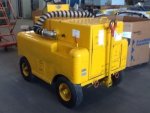soconnoriv
New member
- 12
- 0
- 0
- Location
- CT
Hi all,
I've had an MA-1A Huffer cart for a while now and I'm finally getting around to working on it. Only problem is that nobody on the Internet seems to know where there are Technical Manuals for it.
Anybody here familiar with these machines? My main problem is that there seems to be a stuck relay or a bad connection somewhere. I'm getting power from the batteries at various places/connections throughout the machine, but am not getting any power to the control panel. Looks like there is only one breaker for the entire machine from what I can see, and it's not popped.
Sounds awesome when I jump the starter motor and turn the engine over for a few seconds, but that's about all I can get it to do! What I really need is a wiring diagram!
Any help is appreciated!
Not mine, but here's what it looks like:

Thanks
-Steve
I've had an MA-1A Huffer cart for a while now and I'm finally getting around to working on it. Only problem is that nobody on the Internet seems to know where there are Technical Manuals for it.
Anybody here familiar with these machines? My main problem is that there seems to be a stuck relay or a bad connection somewhere. I'm getting power from the batteries at various places/connections throughout the machine, but am not getting any power to the control panel. Looks like there is only one breaker for the entire machine from what I can see, and it's not popped.
Sounds awesome when I jump the starter motor and turn the engine over for a few seconds, but that's about all I can get it to do! What I really need is a wiring diagram!
Any help is appreciated!
Not mine, but here's what it looks like:

Thanks
-Steve



